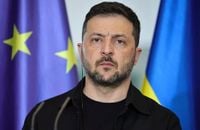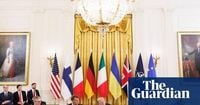On August 18, 2025, the White House became the epicenter of high-stakes diplomacy as U.S. President Donald Trump hosted Ukrainian President Volodymyr Zelenskyy and an array of European leaders for a summit that many observers described as one of the most pivotal geopolitical meetings of the year. The gathering followed closely on the heels of Trump's recent conversation with Russian President Vladimir Putin, adding another layer of intrigue and complexity to an already fraught international landscape.
The tone of the Trump-Zelenskyy meeting was markedly different from their last, notoriously tense Oval Office encounter in February. This time, as reported by the Council on Foreign Relations (CFR), Zelenskyy arrived in a black suit—eschewing his usual army-style attire—and repeatedly thanked Trump for the opportunity. The mood was described as cordial, a notable shift that many attributed to lessons learned from their previous, more contentious exchange. Vice President JD Vance and other U.S. officials were notably silent, a decision interpreted by some analysts as a deliberate move to keep the focus on the two leaders.
Yet beneath the surface pleasantries, the summit exposed deep and enduring divisions over the future of Ukraine, the role of the United States, and the extent of European involvement. According to CFR’s Matthias Matthijs, the meeting was “probably the most important of Zelenskyy’s life,” given the stakes for Ukraine’s sovereignty and security.
European heavyweights—including UK Prime Minister Keir Starmer, French President Emmanuel Macron, German Christian Democrat leader Friedrich Merz, NATO Secretary-General Mark Rutte, Finnish President Alexander Stubb, and Italian Prime Minister Giorgia Meloni—joined the summit for expanded negotiations. Their presence was a show of unity, carefully coordinated in advance and designed to amplify Europe’s voice in the proceedings. As CFR noted, the group represented a broad spectrum of political ideologies, from the Labour-left in the UK to the far-right in Italy, but all were united in their support for Ukraine and a negotiated peace.
The European leaders made their positions clear: they supported a ceasefire as a necessary first step, advocated for prisoner exchanges, and underscored the importance of security guarantees for Ukraine. Keir Starmer, in particular, emphasized the need for robust security commitments, reminding attendees that he had previously pledged British boots on the ground if necessary. Meloni, meanwhile, argued that being on the side of peace was synonymous with supporting Ukraine’s struggle for sovereignty. Stubb declared, “There is ‘Team Europe’ and ‘Team United States,’ and both are on the side of Ukraine.”
President Trump, however, took a more ambiguous stance. While he signaled a willingness to provide U.S. security guarantees for Ukraine—something long viewed as essential for Ukraine’s long-term future—he stopped short of offering specifics. According to CFR, Trump floated the idea of guarantees “similar to NATO’s Article Five,” but implied that Europe would shoulder most of the defense burden. He suggested that America’s role would remain largely transactional: continued weapons sales, intelligence sharing, and perhaps some air support, but no commitment to deploy U.S. troops on the ground.
This ambiguity left many questions unanswered, particularly regarding the form and credibility of any U.S. guarantees. As Matthijs explained, “It is hard to imagine there being any deal today that is acceptable and that respects the red lines of the Ukrainians and Europe as well as the red lines of the Russians.” Russia, for its part, has consistently opposed any deployment of NATO troops in Ukraine, preferring instead the kind of vague, non-binding assurances found in the 1994 Budapest Memorandum. The Russian Ministry of Defense even reiterated this stance on its website during the Washington meeting, underscoring Moscow’s red lines.
Markets and political punters followed the summit with intense interest. According to Trump–Zelenskyy Summit: Betting Odds and Market Expectations, speculative betting markets gave a 63% chance that Trump would mention NATO explicitly—likely in dismissive terms—and near-even odds on whether he would refer to Crimea as “Russian.” Most bettors believed Trump would not announce concrete U.S. security guarantees, reflecting skepticism about any dramatic policy shift. Financial markets echoed this uncertainty: the euro slipped slightly in early trading, and oil prices ticked upward as traders braced for the possibility of a prolonged stalemate rather than an imminent peace breakthrough.
Central to the summit was the question of Ukraine’s future relationship with NATO and its territorial integrity. Trump has repeatedly suggested that Ukraine should “forget about NATO” and “be realistic” about Crimea, setting the stage for a tense face-off with Zelenskyy. The Ukrainian leader, for his part, insisted that any peace must be lasting and not come at Ukraine’s expense. As Trump–Zelenskyy Summit put it, “Zelenskyy insisted that any peace must be lasting and not come at Ukraine’s expense.”
European leaders, meanwhile, pressed Trump for stronger U.S. security commitments. According to CFR, “the usefulness of a ceasefire before any lasting peace deal, the importance of prisoner exchanges, their support for a trilateral, and then quadrilateral meetings with Europe for security guarantees” were all stressed by the European contingent. Yet, Trump’s America-first rhetoric—and his reluctance to promise NATO-style guarantees—left many in Europe uneasy about the durability of any potential agreement.
A trilateral meeting between Trump, Zelenskyy, and Putin was described by Trump as a matter of “when, not if,” though Putin has long resisted such a gathering. The Russian president has refused to recognize Zelenskyy’s legitimacy, labeling him a neo-Nazi and questioning Ukraine’s status as a sovereign state. As CFR explained, “Putin regards Ukraine as illegitimate and has accused Zelenskyy of being a neo-Nazi.” The risk, some observers warned, is that a trilateral summit could pressure Ukraine into making concessions that would be difficult to defend at home or among its European allies.
Trump’s approach has also shifted in recent weeks. Having initially supported the idea of a ceasefire, he now appears to favor a comprehensive peace deal—an approach that critics argue may play into Russian tactics to delay and divide. As one analyst put it, “Trump has moved away from advocating a ceasefire toward seeking a total peace deal. Critics argue this approach may be a Russian tactic to delay the conflict’s resolution.”
For Zelenskyy and his European backers, the best security guarantee remains a strong Ukrainian army, supported by Western weaponry and, if necessary, boots on the ground. As Zelenskyy himself stated, “the best security guarantee for Ukrainian security is a strong Ukrainian army.” The Europeans have committed to higher defense spending and have offered generous trade deals to keep the U.S. engaged, but there is a pervasive sense of ambiguity and frustration over the lack of firm commitments from Washington.
The reality is that the war in Ukraine is likely to grind on in the short to medium term. The summit may have avoided the worst-case scenario, but it fell short of delivering the clarity and assurances that many in Kyiv and across Europe had hoped for. As the various leaders return to their capitals, the delicate dance of diplomacy, deterrence, and negotiation continues—with the fate of Ukraine and the stability of Europe hanging in the balance.


